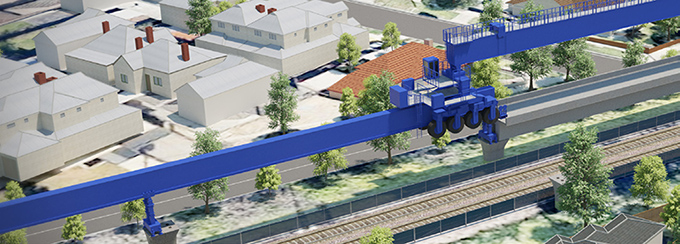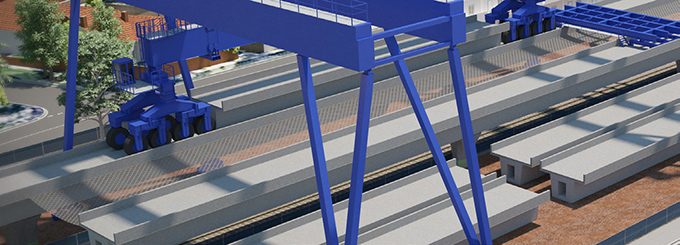1 June 2017
Due to the narrow rail corridor between Grange Road, Caulfield and Poath Road, Hughesdale, specialist equipment, including 2 gantry cranes and a straddle carrier, will be used to construct the elevated rail line.
This innovative approach, a first in Australia, enables trains to continue running while most of the construction occurs to the side of the existing tracks.
How they work
Two gantry cranes, 30m high and 40m wide, are based next to Murrumbeena Station. These cranes will assemble concrete segments into horizontal spans of up to 40m and also do all the heavy lifting of these spans onto the elevated rail deck.
The gantry cranes will move backwards and forwards on purpose-built tracks, which run parallel to the existing train tracks. They operate within a confined area, known as the station assembly area. Each gantry crane can carry up to 230 tonnes.
The gantry cranes will place the first eight spans on top of piers, which will form the first section of the elevated rail deck at Murrumbeena Station.
Once this section is complete, the cranes lift spans onto the elevated rail deck. Then a straddle carrier picks up spans, one at a time, and travels between Caulfield and Hughesdale to lay them onto support piers to form the new elevated rail line.
The straddle carrier uses a 94m long steel support beam that travels ahead to ensure the straddle carrier is in the correct position to lower each span into place.
Advanced engineering in action
This innovative construction method provides many benefits:
- It means we can keep trains running while most construction occurs to the side of the existing tracks, minimising disruptions.
- Segments are assembled in a purpose built area away from the rail line, which reduces the interaction between construction activities and the rail corridor. This creates a safer work environment.
- The span assembly process occurs at ground level and includes lining up segments, joining them together and then stressing them together to form a complete span. This means all works are completed while the span is on the ground, and the amount of time spent working at heights is reduced.
- We are constructing both elevated rail lines at the same time, which means a quicker build time and less disruptions.
Installing the spans
Advanced engineering techniques will be used to construct the elevated rail line. There are four key steps in this process.
1. Lift
Concrete segments arrive on trucks and are lifted onto the ground by the gantry cranes. Segments are joined together into larger horizontal spans of up to 40m to form the elevated rail line. The gantry cranes then lift the new span up onto the elevated rail deck.
- Concrete segments are pre cast to lock together after the gantry cranes lower them into position. They are stressed together to make a span using steel cables threaded through key holes that are locked at the right tension at either end with anchor blocks. This is all done at ground level to reduce the time spent working at heights.
- Assembly and testing of the spans occurs in a purpose-built area away from the train line.
- A protection screen made of heavy duty steel mesh runs the full length of the gantry cranes to protect work areas below.
- The segments are delivered to the assembly area and noise walls are used to minimise impacts on surrounding areas.

2. Move
The straddle carrier collects each span and transports it along the elevated rail deck to its new location.
- The straddle carrier operates beside the existing rail tracks – not above them.
- Stringent checking and testing is carried out to make sure the span is fully secured to the carrier before it moves.
- The carrier is controlled by two specialist operators – located at the front and rear of the carrier – with additional spotters at ground level and CCTV cameras to monitor the straddle carrier's movements.
- A sophisticated cable guidance system ensures the straddle carrier moves along a pre-determined route and doesn't deviate from the rail deck.
- The straddle carrier moves very slowly (up to a maximum speed of 2.5km/hr) when transporting a span.
- In-built safety features include an automated 'off switch', which means both operators must use the system simultaneously for the straddle carrier to move.

3. Place
The straddle carrier moves onto the steel support beam directly above where the new span will be placed. The support beam then moves forwards so the straddle carrier can lower the span onto the support piers.
- The steel support beam provides temporary support for the straddle carrier to achieve the correct position to place the span.
- The support beam moves forward using its own motor and typically extends to a length of up to 50m beyond the last support.
- The support beam, once extended, is supported by legs that are temporarily fixed to the concrete support piers using large threaded bars.
- The span is carefully lowered and securely fixed to the support pier using elastomeric bearings (rubber blocks with steel inside) and steel pins.
- It takes approximately 3 hours to lower and secure each span into place.

4. Repeat
Once the span is installed, the straddle carrier returns to the Murrumbeena Station assembly area to collect the next span.
- The support beam remains secured into position on the support piers ready for the next span to arrive.
- For safety reasons, the straddle carrier will always complete a full cycle of installing a span.
- When unloaded, the straddle carrier can move at a maximum speed of 5km/hr.
- On average, it will take between 6 to 8 hours to complete a full cycle.

View an animation showing how the straddle carrier operates below:
Fast facts
- Each elevated rail deck, between Caulfield and Hughesdale, is 3.2km long.
- The elevated rail line will be built from Murrumbeena to Caulfield, then from Murrumbeena to Hughesdale.
- It will require over 2000 precast concrete segments to construct the 174 spans needed in this area.
- A typical span weighs up to 420 tonnes and consists of 8 to 14 smaller concrete segments.
- It will take 6 to 8 hours to load, transport and install each span.
- The steel support beam is 3m wide and 94m long at full extension.
- All concrete segments are made at a purpose-built factory in Pakenham, supporting local jobs and manufacturing.